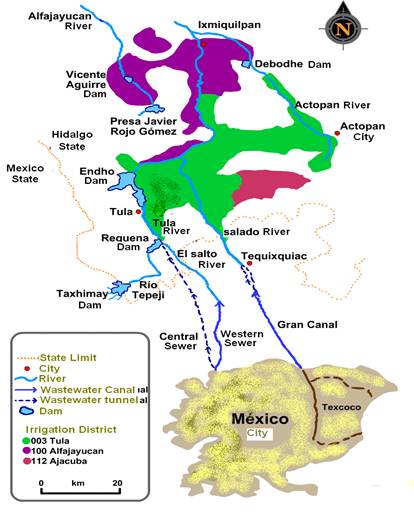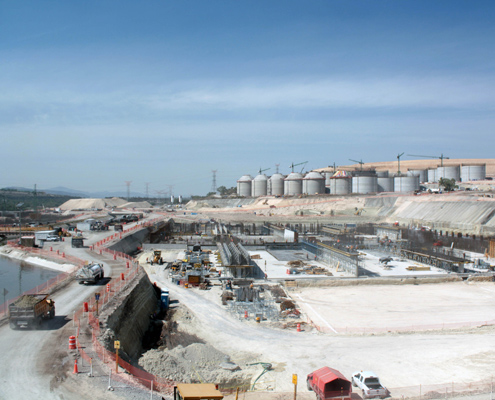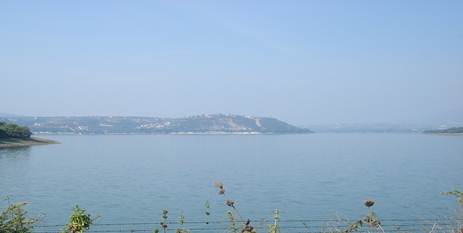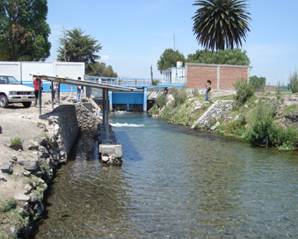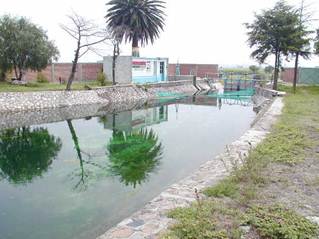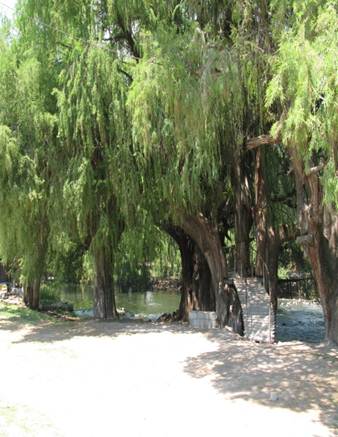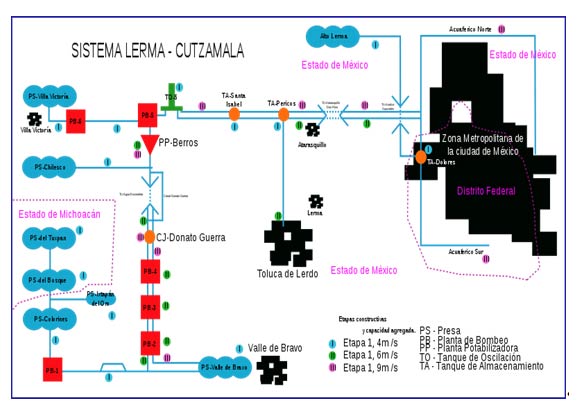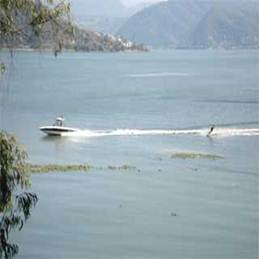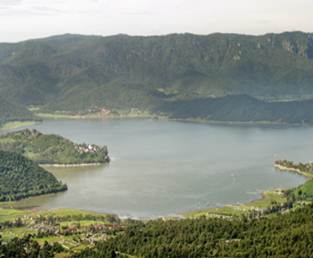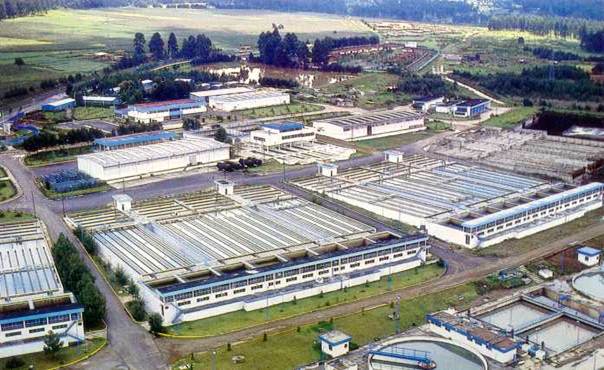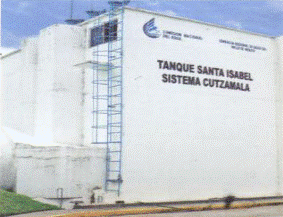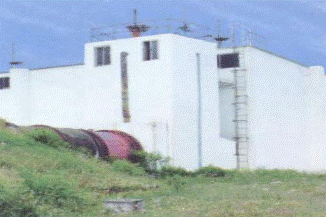
 ________________
________________
Technical Visit _____________________________
There are two technical visits planned for the 29th November, one to the Tula Valley in nearby Hidalgo State, which has been irrigated with wastewater for over 100 years, and the other to the Cutzamala water supply system, which is used to send water to Mexico City from over 100 km away and 1000 m below the city. For more detailed information, please see the following sections.
Technical Visit 1: Tula Valley (or Mezquital Valley)
The Tula Valley is located 80 km north of Mexico City at an elevation of 1,900 masl. Its population is close to 450,000 people distributed over 294 localities. Mean annual precipitation is 450 mm whilst evaporation is 2,100 mm. The main activity in the valley is agriculture, which is practiced in three irrigation districts: 03 (Tula), 100 (Alfajayucan) and 25 (Ixmiquilpan). Together, they represent 90,000 ha. The main crops grown are corn and alfalfa. Due to the salinity in the soils, very high irrigation rates are used (1.5 to 2.2 m) which, combined with the edaphologic conditions and the wastewater transport through 858 km of unlined channels, produces an artificial recharge of the aquifer. This recharge has been estimated at 25 m3/s, and it is equivalent to 13.3 times the original or natural recharge. As a consequence, the water table has raised and several springs have appeared with flows between 100 to 600 L/s. Also, the original flow of the Tula River, the major river in the valley, has increased from 1.6 to 12.7 m3/s in the last 50 years. All this water has favored the development of the region, and constitutes the main source of water. The increase in the demand of water supply in Mexico City from the current value (64 m3/s) and considering the proximity (80 km) and the low difference in altitude (320 m), the new aquifer is being taken into account as an alternative water source. However, since the aquifer has been recharged with raw wastewater, several studies have been performed to analyze this option.
The visit will cover the following four sites:
- “Atotonilco” WWTP
- Endho Dam
- Cerro Colorado Spring
- Tula River
“Atotonilco” Wastewater Treatment Plant (In construction)
When completed, the WWTP will have a capacity of 23 m3/s during the dry season (through a coventional biological process), with an additional 12 m3/s in the rainy season (through a physico-chemical module). All the treated water will be used for agricultural irrigation in the Tula Valley.

Western Emission Tunnel (Túnel Emisor Oriente)
The Western Emission Tunnel (TEO, for its initials in Spanish), has a length of approximately 62 km, a diameter of 7 meters, and a residual water transmission capacity of around 150 meters cubed per second. The tunnel is under construction and will be completed in 2013.
Endho Dam
The Endho Dam was onstructed between 1947 and 1952, with the aims of providing storage and containing the large volumes of residual waters coming from the Valley of Mexico (from both the Federal District and Mexico State).
It has a capacity of 182 Mm3, and covers an area of 1260 ha.
Cerro Colorado Spring
Cerro Colorado spring first appeared about 35 years ago, as a result of the artificial aquifer recharge and heightened water table due to wastewater irrigation. It currently has a flow of 600 L/s, and supplies 500,000 inhabitants.
Tula River
The Tula River recieves wastewater after irrigation, and is a tributary of the River Panuco.
TECHNICAL VISIT 2: Cutzamala System
The Cutzamala System was built in stages from the late 1970s to the late 1990s, to transfer 16 m3/s (23% of Mexico City’s total supply) of water from the Cutzamala River (in the Balsas basin). The water must be raised over more than 1000 meters to reach its destination of Greater Mexico City, where it is used for drinking water. It utilizes 7 reservoirs, a 127 km long aqueduct with 21 km of tunnels, 7.5 km of open canal, and a water treatment plant. Its cost was US$ 1.3 billion. While providing Greater Mexico City with 23% of its water, the Cutzamala system currently operates at only 84% of its total capacity. Both systems are operated by the National Water Commission.
The water distribution system in the Federal District includes nearly 11,000 kilometers of distribution lines and 243 storage tanks, with a total capacity of 1.5 million cubic meters in 1994. Water from all the separate sources is added to the common distribution system. The Federal District also operates a water transmission line (the Acueducto Periférico) that transports water from the Cutzamala System - entering the distribution system from the west - to the southern and eastern part of the district. The State of Mexico system has nearly 800 kilometers of distribution lines and 32 storage tanks with a capacity of 440,000 cubic meters. As of 2000, there were 2.5 million water connections of which 67% were domestic - and this only accounts for legal connections. It is estimated that there could be another 900,000 illegal connections. The State of Mexico operates the 49 kilometer water transmission line (the Macrocircuito) to transport water entering from the west side of the service area (including the imported water from the Cutzamala-Lerma System) to the east side. This transmission line is being upgraded to increase the volume of water taken from the Cutzamala-Lerma system to 7.3 m3/s, and to provide service to the eastern service area. The Macrocircuito is operated by the State Water Commission.
For more information visit: http://www.youtube.com/watch?v=lhSanNkpyHY
The visit to the Cutzamala System will stop at the following locations
- The Bravo Valley Dam
- “Los Berros” Water treatment plant
- Water tanks Santa Isabel and Pericos
Bravo Valley Dam
The Bravo Valley Dam provides 38% of the system total (6 m3/s), and is the largest and most important in the Cutzamala System.
“Los Berros” Water Treatment Plant
This treatment plant forms a part of the Cutzamala System and currently treats 16 m3/s of water from the seven dams used for supply: Tuxpan, El Bosque, Ixtapan del Oro, Colorines, Valle de Bravo, Villa Victoria and Chilesdo.
The system consists of a tank for reception of raw wastewater, filters, clorine dosing, a Parshall meter (where the coagulant is applied), and flocculation, sedimentation and filtration tanks.
Water tanks Santa Isabel and Pericos
Santa Isabel and Pericos are used for storage of the potable, disinfected water, before its distribution to the Metropolitan Zone of the Valley of Mexico (ZMVM, by its spanish initials) through the Macrocircuito and the Acuaférico.


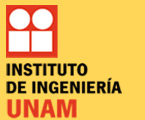
Tel: + (52) 55 5623-3600 ext. 8682 Fax: +(52) 55 5616-2164
